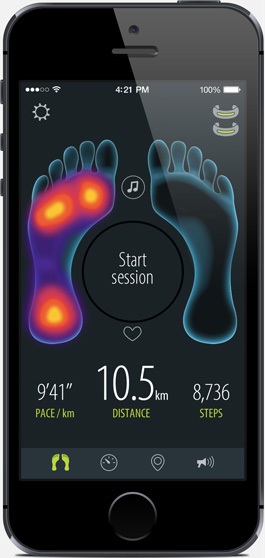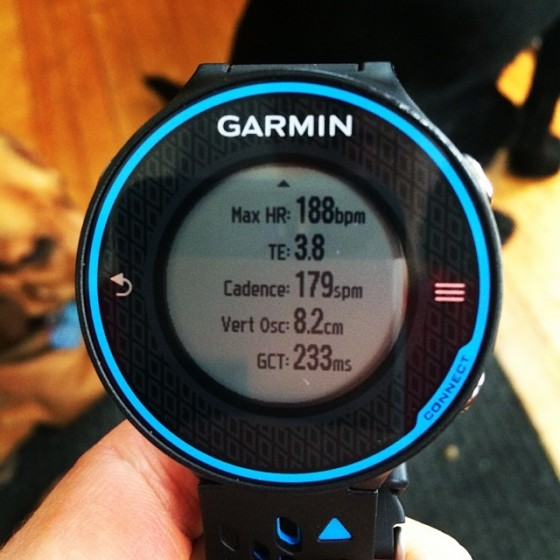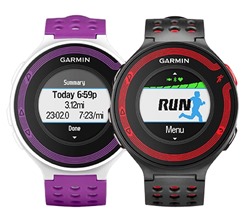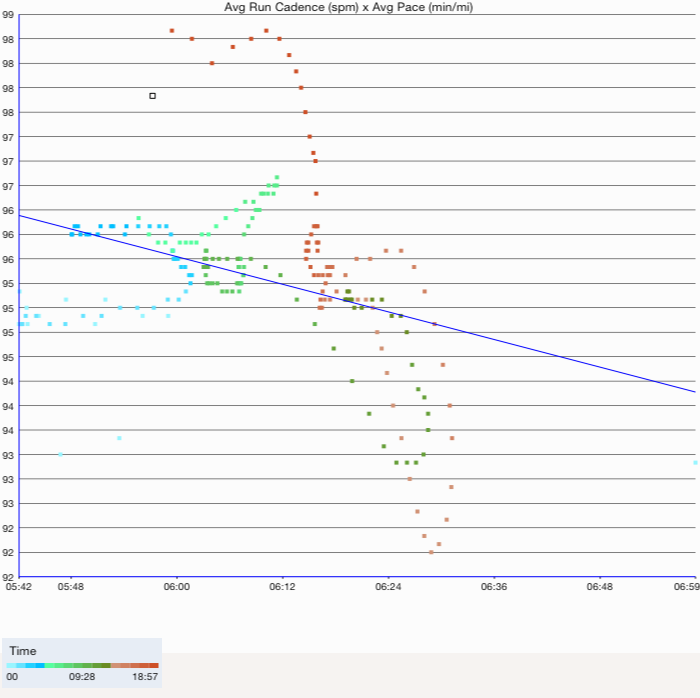One of the big trends I see coming is an onslaught of wearable monitoring devices that can measure aspects of your running biomechanics.
For example, I received a Garmin Forerunner 620 for Christmas. The Garmin 620 is unique among Garmin watches in that it adds in the ability to measure a slew of new variables as part of the new “running dynamics” suite collected by the HRM-Run monitor that pairs with the watch. I’ve only just started playing with the 620 (loving it so far, hopefully will get a first impressions post up soon), but I’m not yet sure what to make of the data it provides me.
Here’s an example data summary from a run from a few days ago:
First off, there’s no way my max heart rate hit 188bpm on that run – it was a slow run with my dog on very icy and wet surfaces – sometimes we need to be aware that these devices make mistakes.
In addition to standard heart rate data, the watch spits out data on Training Effect, Cadence, Vertical Oscillation, and Ground Contact Time.
Very cool stuff, but my questions are:
A) How accurate are these measures?
B) What is the practical significance of this data for a runner like me?
C) How do the data vary with things like speed, terrain, footwear, etc.?
D) What are the normal ranges observed for these data (is there even a “normal”)?
E) If I am way out of the normal range for any of them, is there any compelling benefit to making a change?
D) If I need to make a change, what’s the best way to do so?
F) Is there any risk associated with making a change?
Don’t get me wrong, I’m a data geek, and being able to play with this stuff excites me. One of my goals for the coming weeks is to experiment with the watch and see how the numbers change with various conditions. I also hope to dig into the scientific literature a bit on a few of these variables and see what I can come up with that might be of practical value to everyday runners. But right now they mostly represent a curiosity (maybe with the exception of cadence, which I have a pretty good handle on).
 The issue I have with some of the tech coming out is that complex biomechanical information may get overly simplified to the point where it loses meaning, or may actually do harm. To give an example, Techcrunch recently posted and article on the topic of health tech, and in it they feature the new Sensoria Smart Socks. The Sensoria socks contain textile sensors that can measure foot contact location, and they are thus able to give real-time feedback on foot strike (see Sensoria app image at left).
The issue I have with some of the tech coming out is that complex biomechanical information may get overly simplified to the point where it loses meaning, or may actually do harm. To give an example, Techcrunch recently posted and article on the topic of health tech, and in it they feature the new Sensoria Smart Socks. The Sensoria socks contain textile sensors that can measure foot contact location, and they are thus able to give real-time feedback on foot strike (see Sensoria app image at left).
As someone who works in a clinic doing gait analysis, I can see value in a gadget like this (if it works well) for a client a who has a very good reason to consider altering their foot strike and needs something to help keep them on task.
But, my worry is when you see a line like this one in the Techcrunch article: “The Sensoria smart sock correctly diagnosed that I make the runner’s rookie mistake of heel striking, leading to a workout-stopping knee pain.”
I’m not sure I’d call heel striking a “runner’s rookie mistake,” nor do I think we have any strong evidence to say across the board that heel striking is bad or causes knee pain. What’s more, moving from a heel strike to a forefoot strike poses some amount of risk due to the changes in lower extremity loading that occur. Given that runners often tend to be overly enthusiastic (to put it nicely!) with things that promise performance improvement or injury prevention, the opposite result may be just as likely: The Sensoria tells you you’re a heel striker, you actively try to change that quickly because you think heel striking is evil, and you wind up breaking your foot or shredding your calves.
The point here is that if the Sensoria works as indicated, it could be a very cool tool under the right circumstances, but my fear is that in reality it will be a tool used needlessly to get people to change form who would be better off just staying with what works for them.
So, to end this rant, I’ll say that I’m as excited as anyone about the tech on the way. It allows us to measure things (or at least estimate things since accuracy may not be perfect) affordably that could previously only have been measured in a high-tech lab. But, lets not get overly enthusiastic about the stuff we measure until we have a good understanding of what it is telling us and what the practical meaning of such data is.


















I believe your runblogger is just the type of place that runners around the world could come to make sense of the data they collect for these tech websites.
The devices themselves are all very cool in geeky way but it takes a bit of expertise to properly interpret the results and to know what if any changes one should consider.
I guess one evolution beyond the actual sensor recording will be to smart online resources that can log the results and put them in context, and then make hints either automatically or via a community about what to do next.
For the sports science research community having all this data would also be useful.
W.r.t max heart rate, my HR monitor occasionally mis-reads and I get daft max HR’s too. I presume it’s down to the HR strap contacts not being wet enough/strap slipping a little to an area on my chest that too dry.
Being able to modify HR records to remove these peaks/troughs would be useful. Even better would be for the HR monitor to detect poor contacts and not use reading at that time and give the runner some feedback that it’s not functioning.
Thanks Robert, that’s one of the reasons I wanted the 620 even though I had a perfectly good watch in the 610. Wanted to see if I could make some sense about the data it provides and write about it.
I’ve been running HR monitor free since 2003…or maybe longer. It’s not that I actively didn’t like it, it’s just that I found it unnecessary…and that’s what I find a lot about this data. It’s mostly unnecessary unless you’re at the absolute top end of elite running. Or unless you’re occasionally analysing with your physio to solve a problem.
I’m not saying that data is completely absent from my life, I might analyse my training stats or cadence once a month, or splits more frequently. But a lot of it you only need when you’re working in collaboration with a sports science pro.
Regarding the TechCrunch article, it was overly optimistic and simplistic. Automation of health tech will be tweaked over 20-50 years, it won’t be perfected in 2014. To recite a point I made in one of the comments: “This argument of one has to lose for the other to win is doing no good. The future of health and fitness will benefit by embracing both a BALANCE of automated technology AND human creativity.”
I’ve been wondering about the accuracy of the HRM being used with my 220. It has my heart rate staying at around 175-183 for almost an entire run. It seems to measure my resting heart rate at 48 if I’m laying down. I just don’t know if I need to correct something or if there really is an issue. I just got concerned that it shows my training being stuck around 100% effort even though it doesn’t feel anything like it
Is that even for an easy run? That’s pretty high. Do you have another HRM you can use to test against? Might have gotten a bad HRM. 48bpm is not out of the question as a resting HR for a very fit runner.
It seems to stay in the same range whether I’m on a 4-5 mile run averaging between a 8:30 min/mi pace and a 8:45 min/mi pace or on a 6+ mile run at an average of 9:00 min/mi+
When I ran a 5k on New Year’s and pushed for the first mile to hit a 7:34 pace it still had my heart rate between 176 and 186.
According to Garmin tech support the values “seem” accurate, but I never feel like I’m pushing myself to the point of high exertion.
Unfortunately I do not have another HRM to compare to as this was my first foray.
Stop and do a short manual count to verify and compare to your HRM. Finger on neck, count heartbeats – for six seconds and multiply by 10, or 10 seconds and multiply by 6. If you are careful to line up you zero second count with a heartbeat, you can count within a 1/2 heartbeart. For example, 12.5 heartbeats in 6 seconds = 125 bpm. That’s what we did in the 80s when I was in high school.
I gave up on my Garmin HR straps due to bad readings. I bought a Magellan which is compatible (ANT+) and rated highly by dcrainmaker. Works much better.
It could mean you have a high maximum heartrate. It could also mean you are running way too fast. You could be hitting your max without feeling like you are exerting much, especially if you frequently run too fast (read: like a lot of people).
Unless you have been tested professionally for your max heartrate, I would not pay much attention to what your heartrate is…
I try to slow down, but it feels I’m exerting more effort when I do. I’ve gotten my cadence to 160+ and it feels great. When I slow down it feels like I bounce. Maybe I’ll try the treadmill and see what reports for HR.
I agree, could be a combo. Lots of people feel they need to go fast every time out. Would be interesting to see if manual measure of heart rate confirms what the monitor says.
I’ll do a manual test on my 5 mile run tomorrow. I just did a manual test and compared the values to the HRM while sitting at my desk and they seem in-line.
How does one slow down without affecting their gait? I won’t say that I’m the most efficient runner, but my speed has slowly improved. I went from running a 27:32 5K on 5/8/13 to running a 24:47 5K on 1/1/14 with a little bit of walking both times.
I want to be able to slow down on runs so that I can do HR based training, but it seems that my HR stays within the same range now even when I incorporate surges into the runs.
Well, it appears that the values are accurate when I’m standing still.
I stopped mid-run and took a manual reading and it was close to the what the watch reported. Simply stopping from a run to standing drops my HR from 180 to 150. Is it possible for a HR to drop 30 in 15-20 seconds?
Like Robert says, my readings are usually crazy high for the first 10 min or so if I don’t remember to wet the contacts before heading out. Another owner’s manual tip I have found to be anecdotally true is that synthetic fabrics (and their static producing properties) confuse the HRM. Cotton seems to work better. I have a new Icebreaker 100% Merino shirt I’m going to try next for comparison’s sake.
The points raised in this post reminds me that data is only as useful as the contextual analysis applied to it. You could have all the accurate real-time biomechanical information at hand, but they’re really just meaningless numbers without a properly realized theoretical and practical framework.
Peter –
Great rant/points.
The following particularly resonated with me: “It allows us to measure things (or at least estimate things since accuracy may not be perfect)affordably that could previously only have been measured in a high-tech lab.”
Aside from your basic activity trackers (Fitbit, Basis, Withings, Jawbone, Shine, etc.)this is still a very immature product category.
The affordability and the accessibility is definitely the first step and hopefully these devices will continue to get progressively smarter; however, without a (relatively) significant amount of education, I fear that many of these devices will, as you alluded to, bring more questions than answers.
That’s why, for those serious about advancing their training efforts, I’m a pretty big proponent of pairing these devices with a personal coach and/or someone who can synthesize the data and produce actionable insights.
For example, social media monitoring software can tell me how many people mentioned my brand, but still, 7+ years later, struggles to get the sentiment correct.
Supplementing a real-life coach with these devices is instrumental for optical success – in my humble opinion.
I’m biased by the fact that I do gait analysis out of a clinic now, but I agree with you.
One of my New Years Resolutions was to put my GPS watch in a drawer. I run by time, but with only an old Timex Ironman. Must say I really enjoy it. I don’t “race” myself on Strava anymore and I like logging hours…makes me feel like a pilot!
I was playing with Strava a bit the past few weeks and initially the racing yourself part intrigued me. Now not so sure it would be a good thing to have that in my head pushing me too run too fast…
Parker Spectra 360 solves all those HR strap issues.
I have not had a bad reading since using that stuff.
While that watch looks cool, I trust my own body and intuition more than a device like that. How my body feels will be my guide for what I need to work on or fix. It seems to me that the only gizmos you need are the most basic GPS watch (to know how far and fast you’re going) and occasionally a metronome (to make sure you’re keeping your turnover rate up).
The problem there though is the most basic GPS watches don’t work as well at GPS as the more exoensive ones. I’m getting an Ambit2 for the quality of features, not the quantity, and it seems to have less bloat than the new high end Garmins.
I agree, there can (and probably will) be some downsides with all this stuff. But on the upside, I would not have been running and cykling and doing other stuff i do on a regular basis, if i did not have the gadgets I use. I have never seen myself as a geek or a gadget freek, maybe I have to reconsider…
I’m with you, I love gadgets as much as I love shoes :)
I think the gadget we really need are not even available, yet. Like real-time cortisol and lactate monitors and other sensors for key physiological markers.
I listen to my body plenty, but I have such a high tolerance to effort and pain, it’s very easy for me to do more than I should.
I’ve been very happy with my 620. The distances are consistence with both online mapping and phone apps.
As for the HRM, the treadmill I run on at my gym has HR grips. Of the 3 treadmill runs I’ve had with my Garmin 620 I’ve checked HR several times on each run. Each time the treadmill and Garmin were within +/- 2 bpm of each other.
Also the pace of the treadmill and Garmin were in line. When running on the treadmill I do not use a footpod and turn GPS off.
I think this is a wonderful device but it’s not perfect. In the words of Louis CK “It’s talking to a satellite in outer $#@! space!” so there’s going to be some errors. We just need to take all this data with appropriate expectations.
Love that quote!
The wearable tech market is still a work in progress and you raise legit concerns because while all this tech is great it could create some false positives on results/ or just incorrect measurements.
I leverage tech while I run but also listen to my body as much as possible. I think it’s important to balance the two and never completely rely on tech.
However, years from now the whole tech market for running will evolve and provide more accurate sensor data. Exciting times lie ahead
I agree, the next few years are going to be very interesting!
Re high HR. Possible Atrial Fibrillation?
The best thing I learned from using a HRM is what my LSR pace should be. It worked out to almost a minute per km slower than what I thought. I actually found it hard to run that slow for the first few times.
The upside is that by running slow on my long runs and my ‘recovery’ days, I didn’t feel nearly as still or so the following days and could run a lot harder on my speed and hill sessions and increase my overall mileage substantially without injury. As a result, I was able to take 10 minutes off my 1/2 marathon PR in 4 months.
Now that I know what a LSD effort feels like however, I find the HRM superfluous. I pull it every month or so to ‘check-in’ but for the most part (thanks to so many runs listening the HRM) I have a become a pretty good judge of effort and pace and can ‘run naked’ with confidence.
I’m not clear on what is the downside for you.. the fact that you have too much data that you may or may not want to do something with?
Personally I am not interested in a lot of the information these watches give, but I am interested in some (pace and distance basically) and that’s what I use the watch for. I think running watches are an incredible tool and very useful to have, especially if you are relatively serious about your training. The extra data that means nothing to me (at least for now) I just disregard.
Hope you enjoy the watch for what it’s worth, I have the 220 which is the ‘simpler’ version of the 620 and I’m loving it.
Well said.. we can make gadgets work for us, they can help to motivate us and inform us with useful info, but don’t be a slave to the data. Understand your own body and how you feel fist and foremost.
Have you tried running the same course with different shoe types and compare your cadence, vert osc, and GCT? Is this thing sensitive enough to tell a minimal shoe from a regular one?
Not yet, need to do this!